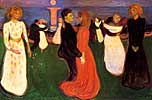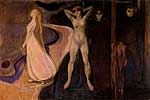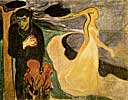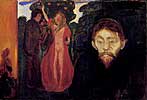| The
Dance of Life, which Munch pained in 1900, takes place on
a bright summer night along the shore of Aasgaardstrand in Oslo
Fjord. Lit by a full moon, couples engage in an energetic dance.
The phallic reflection of the moonlight in the water gives the scene
a mood of sexuality. In the center of the painting, a man in a dark
suit and a woman in a red dress are sunk within each other. Both
of them are in the prime of their lives. The woman's dress wraps
around his legs, a couple of strains of her hair reach out towards
him. His eyes are closed; the two seem totally self-absorbed and
oblivious of others. On the left side a young girl in a white dress
and a smile on her face enters the scene. Her hand reaches out towards
a flower in front of her. On the opposite side, an old woman stands
in a black dress. She watches the dance of the center couple with
a bitter facial expression, her hands folded in withdrawn.
Besides the
use of color, Munch deepens the differences of the three females
by the different use of lines that outline the figures. The adolescent
girl on the left is enclosed with sensitive, vibrant strokes.
A "swathing, ingestive" line coils around the center
female "with her evident appetite for life" (Eggum,
Edvard Munch 167). In contras, the dark woman on the right, who
appears to have withdrawn from the dance of life, is outlined
by angular and rigid lines (Eggum, Edvard Munch 168).
The Dance
of Life belongs to a series called the Frieze of Life.
This frieze was intended as a series of freely adjoining pictures,
which would give a clear view of life and the situation of modern
man. Munch wrote: "Through them all there winds the curving
shore line, and beyond it the sea, while under the trees, life,
with all its complexities of grief and joy, carries on" (Stang
103). The three major themes of the Frieze of Life, love,
anxiety and death are clearly expressed in The Dance of Life.
Thus, this painting can be seen as one of the centerpieces in
the series.
Munch's painting
The Dance of Life can be interpreted from various viewpoints
and on various levels. The transition of the female figures from
adolescence to sexual maturity to old age gives argument that
the painting deals with the everlasting cycle of life. In this
"bright summer night", Munch writes, "life and
death, day and night go hand in hand" (Messer 94). Indeed,
death is the birth of life, and Munch realizes this. "Munch
expresses his awareness about the biological cycle of human existence
by the way he dissolves the figures into the landscape, as if
their destiny is indivisible from the higher rhythm of nature"
(Edvard Munch 78).
The search
of this "higher rhythm of nature" is a primary concern
of Munch's art. His particular interest lies in the subject of
women as a mystery to man. The differing aspects of the female
psyche are clearly expressed in his painting Woman in Three
Stages (c. 1894), which can be seen as an important point
of origin for The Dance of Life. The similarities between the
two paintings are obvious. In Woman in Three Stages Munch
also displays three women of different ages. A virgin figure with
her "innocent phantasies of adolescent" (Edvard Munch
84) gazes out to the sea. In the middle stands a physical mature
woman, naked with her legs spread, who looks directly at the viewer.
Her "seductive and provocative gaze is of such irresistible
attraction that it guarantees the eternity of the human race"
(Edvard Munch 84). On the right side is a darkly dressed woman,
hardly visible, with a pale face that bears witness to death.
"Woman in her many-sidedness", Munch wrote, "is
a mystery to man. Woman at one and the same time is a saint, a
whore, and an unhappy person abandoned" (Heller 34). It is
this "many-sidedness" of women that also finds a clear
expression in The Dance of Life.
Comparing
The Dance of Life to other paintings of the Frieze of
Life, one comes to notice that this painting also deals with,
as Munch put it, "the battle between man and woman that is
called love". Indeed, The Dance of Life seems to summarize
works like Eye in Eye (c. 1894), The Kiss (c. 1897),
Separation (c. 1896) and Jealousy (c. 1895). In
a story like way, these paintings display the process of love,
"that moves from initial flirtations, to the ecstasies of
physical love consummation, then to the anxieties of jealousy
and rejection" (Heller 31). Thus, the young and innocent
girl in white becomes the symbol of the joyous and lighthearted
beginning of a relationship between man and woman. The center
couple displays the immense power of love over two beings. At
this point, the couple seems unable to notice anything around
them. At the end, however, we see the old, disillusioned woman
as a symbol for the fleetingness of feelings and for inevitable
separation.
Finally,
one can find a very personal interpretation for The Dance of
Life. Munch's first romantic experience with a cousin-by-marriage,
to which Munch gave the pseudonym "Mrs. Heiberg", provided
him with his own experience of the process of love. After an impassioned
and joyous love affair she severed their relationship in the late
1880s. For Munch this was an emotionally painful experience, which
he would struggle with for decades to come. "How deep of
a mark she must have dug into my heart so that no other image
can ever totally erase hers", Munch wrote in 1890 (Heller
28). A later love affair with Tulla Larsen, Munch found oppressive.
He continually retreated from her, unable to respond to the intensity
of her affection (Müller-Westermann 79). Knowing these biographical
details, one might suspect that The Dance of Life is rooted
in Munch's relationships with Mrs. Heiberg and Tulla Larsen. The
man in the center of the painting is Munch himself, dancing with
his old love, Mrs. Heiberg. Tulla Larsen is displayed on the left
wanting Munch's love and on the right side, she stands rejected
by him. Munch's description of the painting in his diary supports
this interpretation:
I am dancing
with my true love - a memory of her. A smiling, blond-haired
woman enters who wishes to take the flower of love - but it
won't allow itself to be taken. And on the other side one can
see her dressed in black troubled by the couple dancing - rejected
- as I was rejected from her [Mrs. Heiberg's] dance (Müller-Westermann
78).
As Munch
was rejected by his first love, Tulla Larsen in turn is now rejected
by Munch. Both of them, painted in black and turned towards each
other, find themselves as partners in suffering (Müller-Westermann
79).
The possibility
of various different interpretations of Munch's painting The
Dance of Life is clearly fascinating. Through his revelation
of his most personal experiences, Munch strives to create universal
symbols and values. Thus, this painting becomes a "parable
of human existence and of destiny that dominates our adventure
on earth" (Edvard Munch 84).
Work
Cited
Edvard Munch. Catalog of an exhibition held in Museo d'arte
moderna, Lugano, Sept. 19-Dec. 13, 1998. Ed. Rudy Chiappini.
Lugano, Swizerland: Museo d'arte moderna, 1998.
Eggum, Arne. "A Biographical Background." Edvard
Munch. The Frieze of Life. Ed. Mara-Helen Wood. London: National
Gallery Publications, 1992. 15-24.
Eggum, Arne. Edvard Munch: paintings, sketches, and studies.
Trans. Ragnar Christophersen. New York: C.N. Potter, 1984.
Heller, Reinhold. "Form and Formation of Edvard Munch's Frieze
of Life." Edvard
Munch. The Frieze of Life. Ed. Mara-Helen Wood. London: National
Gallery Publications, 1992. 25-37.
Messer, Thomas M. Edvard Munch. New York: Harry N. Abrams,
Inc., 1985.
Müller-Westermann, Iris. "The Dance of Life." Edvard
Munch. The Frieze of Life. Ed. Mara-Helen Wood. London: National
Gallery Publications, 1992. 78-79.
Stang, Ragna. Edvard Munch, the man and the artist. Trans.
Geoffrey Culverwell. London: Fraser, 1979.
Back
to the top
|
|
|
|
Read
text black on white






|



















